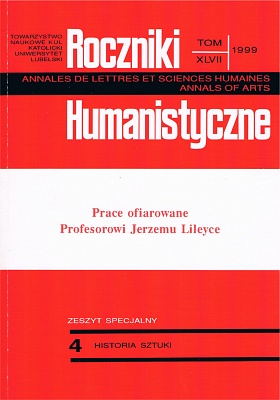„Statuae cudowne, nie złoteć ale kosztowne”. Z dziejów Villa Regia w Warszawie
Abstrakt
In 1643 Andrzej Jarzębski's work „Gościniec albo krotkie opisanie Warszawy” („The Road or a Short Description of Warsaw”) appeared in print. In it Warsaw's appearance and historical monuments were described that existed before the city was destroyed during the Swedish invasion in 1655-1656.
One of the most important places in Warsaw in the first half of the 17th century was the royal residence called „Villa Regia” that was built by the Vasas– now it is in the area of the Warsaw University campus. As we learn from Jarzębski's description, it was originally decorated with numerous sculptures and fountains, made both of metal and marble, placed all over the area. Most of those figures were probably brought to Warsaw around 1637 on the occasion of King Władysław IV Vasa's wedding to Archduchess Cecilia Renata that took place in that year. The few preserved sources (e.g. letters of the pope's nuncio to Warsaw, Marius Filonardi) show that many of them were brought to Poland from Italy, perhaps from Florence. In „Gościniec”, among others, the following historical monuments are mentioned: a sculpture representing Hercules defeating the centaur Nessus, a fountain decorated with the figure of Neptune, a fountain decorated with a figure of a child taming a dolphin, a figure of Cupid with a bow placed beside the gutter, and also two sculptures presenting horses, one of which, standing on his hind legs, was being bitten by a snake. The figures of Hercules with the centaur and of Neptune were perhaps made in the circle of Giovani da Bologna's disciples, as in this master's oeuvre we often come across this subject (see Fig. 1-2). In the Tuscany workshop also the fountain decorated with the sculpture of Neptune was probably made. The sculptures of horses probably reminded the ones that Adriaen de Vries created for the residence of the outstanding art patron, Albrecht Waldsztejn in Praga at the beginning of the 17th century (see Fig. 3-4).
Both the sources from which the monuments from „Villa Regia” come are very probable. It is well known that in his youth (in the years 1624-1625) Władysław IV visited a lot of Italian cities, among them Florence, acquainting himself with the monuments and artistic collections there. He also made contacts with Albrecht Waldsztejn several times.
As it may seem, the sculptures from the royal residence did not only have decorative functions, but they also had symbolic contents. The sculpture of Hercules defeating Nessus could be an allegory of the struggle between good and evil, as well as man's struggle against his own passions and weaknesses. The figure of the putto taming the dolphin may symbolise the mastery of hurry and hastiness, that is the virtue of Discernment. The figures of the two horses: the one stepping quietly and the one being bitten by a snake might be similar to man's two attitudes: keeping to the way of God's commandments and to the way of sin.
Most of the figures described by Jarzębski are irretrievably gone. Some of them are probably still lying on the bottom of the Vistula, as the barge on which the Swedes tried to take away from the Polish capital their spoils sank not far from Warsaw. The only preserved figure is the sculpture of the dolphin that was drawn out of the river in 1906. It is now in the Historical Museum of Warsaw (Fig. 6).
Copyright (c) 1999 Roczniki Humanistyczne

Utwór dostępny jest na licencji Creative Commons Uznanie autorstwa – Użycie niekomercyjne – Bez utworów zależnych 4.0 Międzynarodowe.





